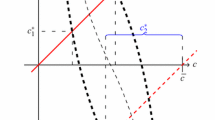Abstract
We consider a market which has two software firms without copy protection on their software. Economic models are used to analyze different scenarios, and the result shows that when the software protection environment is improving quickly, software firms should not protect their software products, since no copy protection (piracy) can help them to lock-in customers now and make higher profits in the near future. However, if the protection environment does not improve enough or worsens, firms that do not protect their software will not be able to benefit from the customers locked-in by pirate software, and they will be better off protecting their software products.



Similar content being viewed by others
References
Altinkemer K, Guan J (2003) Analyzing protection strategies for online software distribution. J Electronic Commer Res 4(1):34–48
Beggs A, Klemperer P (1992) Multi-period competition with switching costs. Econometrica 60(3):651–666
Conner KR, Rumelt RP (1991) Software piracy: an analysis of protection strategies. Manag Sci 37(2):125–139
Eining MM, Christensen AL (1991) A psycho-social model of software piracy: the development and test of a model. In: DeJoie R, Fowler G, Paradice D (eds) Ethical issues in information systems. South-Western Publishing Company, Cincinnati, pp 182–189
Givon M, Mahajan V, Muller E (1995) Software piracy: estimation of lost sales and the impact on software diffusion. J Mark 59:29–37
Glass RS, Wood WA (1996) Situational determinants of software piracy: an equity theory perspective. J Bus Ethics 15:1189–1198
Gopal RD, Sanders GL (1997) Preventive and deterrent controls for software piracy. J Manag Inf Syst 13(44):29–48
Gopal RD, Sanders GL (1998) International software piracy: analysis of key issues and impacts. Inf Syst Res 9(4):380–397
Gopal RD, Sanders GL (2000) Global software piracy: you can’t get blood out of a turnip. Commun ACM 43(9):82–89
Hotelling HH (1929) Stability in competition. Econ J 39:41–57
Johnson EJ, Moe W, Fader PS, Bellman S, Lohse J (2000) On the depth and dynamics of online search behavior. Working Paper, The Wharton School
Klemperer P (1987) Markets with consumer switching costs. Q J Econ 102(2):375–394
Lanjouw JO (1998) Patent protection in the shadow of infringement: simulation estimations of patent value. Rev Econ Stud 65(4):671–710
Lyman J (2001) Microsoft in hot pursuit of software pirates. News Releases, http://www.newsfactor.com/perl/story/8641.html
Mansfield E (1986) Patents and innovation: an empirical study. Manag Sci 32(2):173–181
Moores T, Dhillon G (2000) Software piracy: a view from Hong Kong. Commun ACM 43(12):88–93
Moorthy KS (1988) Product and price competition in a duopoly. Mark Sci 7(2):141–168
Padilla AJ (1992) Mixed pricing in oligopoly with consumer switching costs. Int J Ind Organ 10(3):393–411
Padilla AJ (1995) Revisiting dynamic duopoly with consumer switching costs. J Econ Theory 67(2):520–530
Smith MD, Brynjolfsson E (2001) Consumer decision-making at an Internet shopbot: brand still matters. J Ind Econ 49(4):546–556
Takeyama LN (1994) The welfare implications of unauthorized reproduction of intellectual property in the presence of demand externalities. J Ind Econ 42(2):155–166
Varian H (1980) A model of sales. Am Econ Rev 70(4):651–659
Acknowledgements
The comments of an anonymous referee are gracefully acknowledged which made the paper a better one.
Author information
Authors and Affiliations
Corresponding author
Rights and permissions
About this article
Cite this article
Altinkemer, K., Guan, J. & Şahin, A. Online software distribution without enforcing copy protection as a strategic weapon. ISeB 3, 343–361 (2005). https://doi.org/10.1007/s10257-005-0009-2
Published:
Issue Date:
DOI: https://doi.org/10.1007/s10257-005-0009-2




